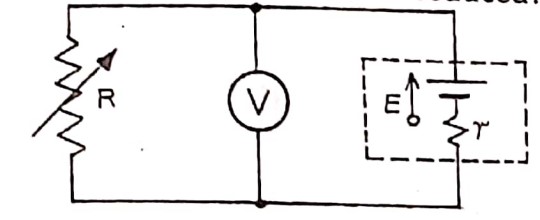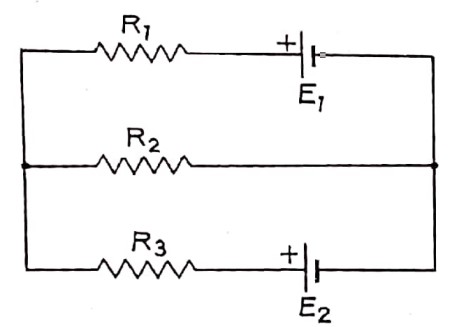Long Answer Type [A]
1
What is an electric cell? Define emf of a cell. On what factors does the emf of a cell depend?
Solution




2
Define the emf of a cell in terms of the work done in moving a charge through the cell. Using Joule’s
law obtain the equation, emf =I(R+r).
Solution




3
Differentiate between emf and PD for a cell. Derive relationship between the two.
Solution








4
The figure below shows a cell of emf E and internal resistance r , connected to a voltmeter V and a
variable resistance R. Deduce the relationship among V, E, R and r. How will V vary when R is reduced?
 Solution
Solution


 Solution
Solution


5
When a battery of emf E and internal resistance r is connected to a resistance R, a current I flows
through it. Derive a relation among E, I, r and R.
Solution


6
State and explain Kirchhoff’s laws for electric circuits. What are the conservation laws implied in each
law? State the sign convention for current and emf. Use the given circuit for your explanation.
 Solution
Solution




 Solution
Solution




7
ncells each of emf E and internal resistance r are
connected in series to form a row. m such rows are connected in parallel to form a battery of N = mn
cells. This battery is connected to an external resistance R.
(i) What is the emf of this battery and how much is its internal resistance?
(ii) Show that current J flowing through the external resistance R is given by
I =

(i) What is the emf of this battery and how much is its internal resistance?
(ii) Show that current J flowing through the external resistance R is given by
I =
Ne
/
mR + nr
Solution


8
n identical cells, each of emf E and internal resistance r, are connected in series to a resistor R.
Deduce an expression for the internal resistance r of one cell in terms of the current I in the circuit.
Solution




9
Obtain the relation R1/R2 = R3/R4 for a Wheatstone’s
bridge. The symbols have their standard meanings.
Solution






10
Draw a circuit diagram for comparing two resistances using a metre-bridge. Give the principle of the
experiment. Why is the method suitable for two resistances of the same order of magnitude?
Solution








11
With a circuit diagram, explain briefly how a metre bridge can be used to find the resistance of a given
wire. State the formula used.
Solution




12
Explain with diagram, the principle of a potentiometer.
how can its sensitivity be increased? Why is it superior
to a voltmeter?
Solution




13
Draw a labelled circuit diagram of a potentiometer to compare emf’s of two cells. Write the working
formula (Derivation not required).
Solution


14
Draw a neat labelled diagram of a simple potentiometer used to measure the emf of a cell and explain
briefly its principle.
Solution






15
Draw a labelled circuit diagram of a potentiometer to measure internal resistance of a cell. Write the
working formula. (Derivation not required).
Solution


Long Answer Type [B]
1
Define emf of a cell and its terminal potential difference. Show that emf of cell is greater than
terminal potential difference, when current is withdrawn and emf is lesser when cell is being charged.
Solution








2
Draw circuit diagram of a balanced Wheatstone bridge and obtain the relationship among the resistors
used. Wnite its applications.
Solution








3
State Kirchhoff’s laws for electric circuits and write
the corresponding association of conservation of the
quantities. Draw diagram in support of laws.
Solution










4
Write the principle of potentiometer, draw its circuit diagram. How its sensitivity can be increased?
Why it is called as ideal voltmeter?
Solution




5
Draw circuit diagram of potentiometer to determine internal resistance of a cell. Derive the formula
used for internal resistance of a cell.
Solution




6
Write the factors on which internal resistance of a
cell depends. How does current terminal potential difference of a cell and energy supplied to the load
(resistor) change with internal resistance of a cell?
Solution



